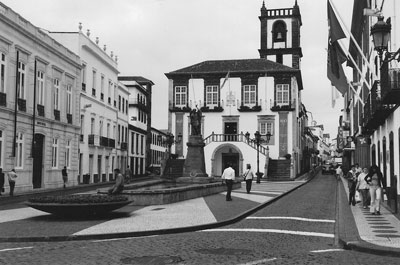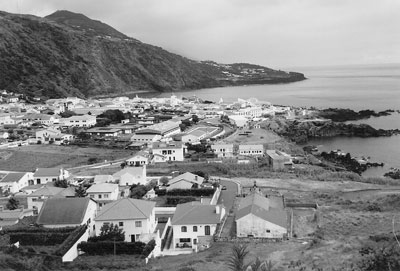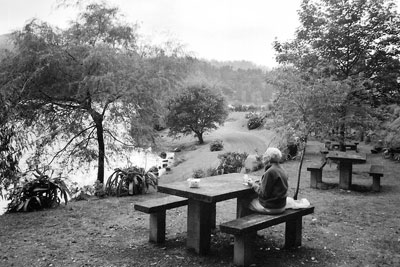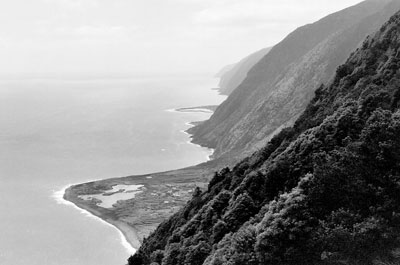Azores pleasures
It’s easy to understand why the Azores, lying in the Atlantic about 800 miles off the coast of Portugal, has never been a stop on any grand tour of Europe. These Portuguese islands boast no great art or museums, have no must-see sights and aren’t known for their beaches or nightlife.
But here’s what they do have: to reach them, a shorter flight from the US than it takes from the US to mainland Europe; volcanic attractions like thermal springs, lava tubes and fumaroles (openings in the earth emitting hot water and steam); views from a Cézanne palette with his greens, oranges and whites, not to mention whitewashed houses with their tile roofs set against the intense green of the fields; a floral heaven with countless flowers and shrubs; ideal temperatures; litter-free towns and countryside; good fish to eat; moderate meal prices, and arguably the nicest and most courteous people we’ve encountered on over 30 trips to Europe.
On a June visit, my wife, Alice, and I spent 18 days on four of the Azores’ nine islands. On three of them (São Miguel, Graciosa and São Jorge), we rented cars so we could explore the countryside. On the fourth, Terceira, we just stayed in the city of Angra do Heroismo, a UNESCO World Heritage Site.
Antonio at Azores.com (visit www.azores.com or, in the US, call 800/652-9151) made all our arrangements, including scheduling our flights to/from Boston plus interisland flights on SATA, car rentals and lodging.
Trying to see all nine islands on one trip would be too much of a job, and far too much time would be spent at airports, so we selected three for these reasons: São Miguel since it’s the one we fly to/from Boston and it’s the largest island and contains the greatest number of interesting things to see; Graciosa, the second smallest, because of its rural, laid-back atmosphere, and São Jorge because of its towering cliffs above the sea, its views of the other islands, and plenty of places to take countryside strolls.
Our hotels ranged from “top” ones — like the Angra Garden on Terceira with its warm indoor swimming pool and Hotel São Jorge with its outdoor seawater pool set in a beautiful garden with wonderful views of the volcano on Pico island across the water — to modest ones like the Residencial Ilha Graciosa, whose breakfast room surrounds a huge old wine press.
The Azoreans are big eaters, for the Azores’ economy is still based on agriculture and fishing and these call for big appetites, but the servings were too much to eat for my wife and me. So we’d go light on lunch, dropping into a snack bar or café and just having drinks, a shared sandwich and/or pastry and coffees.
Portuguese food is good, especially the grilled fish and other seafood, but it’s not gourmet. Whatever you order probably will be served with French fried potatoes, a bit of salad and some rice — but a huge portion!
We’d often start off with soup, after being served bread with some of the country’s wonderful cheeses. Then we’d share the main course. Besides regular fish, like grouper, we had meals of arroz con marisco (rice with mollusks) and cataplanas (seafood and other stews cooked in metal containers). I loved the tiny grilled squid; my wife didn’t.
For desserts there was usually a very good pudim flan (a flan a bit more on the pudding side than a French one). Then coffees. All accompanied by a bottle of one of the Azorean wines: a red Basalto or Terras Lava or a white Vinha Verde.
For the amount of food we were served, prices were very reasonable: €11-€37 (near $16-$55) for the two of us.
Though we felt there are no “must sees” in the Azores, here are some of the things you might like to see.
• On Graciosa, Furna do Enxofre — 200 stone steps take you down to the bottom of a caldeira (cone of an extinct volcano), where you face an underground lake of sulfurous water in a large cave.
• The fumaroles near Furnas on São Miguel — where the locals use the thermal heat to cook cozido (stew).
• Donkey carts — still seen in the countryside, especially on Graciosa.
• The cliffs on São Jorge — towering over 1,000 feet above the sea. Often at the foot of a cliff one finds a small, flat piece of land called a fajã holding a small village. Three or four of these fajãs have narrow, scary roads leading down to them; the rest are accessible by trail only.
• The Gorreana Tea Farm on São Miguel — the only tea plantation in the whole of Europe.
• The large thermal pool at Furnas — full of warm, opaque water surrounded by an almost tropical park.
• Colorful flowers, shrubs and hedges — everywhere, and of species too numerous to count. A botanist’s dream!
Do the Azores have a downside? To be honest, you can’t count on having the sun all day every day. We had some drizzle and fog (that’s why the plants love it there). When we ran into heavy fog in the hills of São Jorge, we drove to a low-lying fajã where the views were clear. When one day we couldn’t see the almost-stereotypical volcano on Pico, shrouded in clouds, the next day it gloriously appeared.
The Azores are not a destination for those visiting Europe for the first time or even the second. They are a place for those, like us, who, frankly, are getting along in years and enjoy a quiet trip to a remarkably beautiful place.
BILL STELTZER
West Grove, PA





